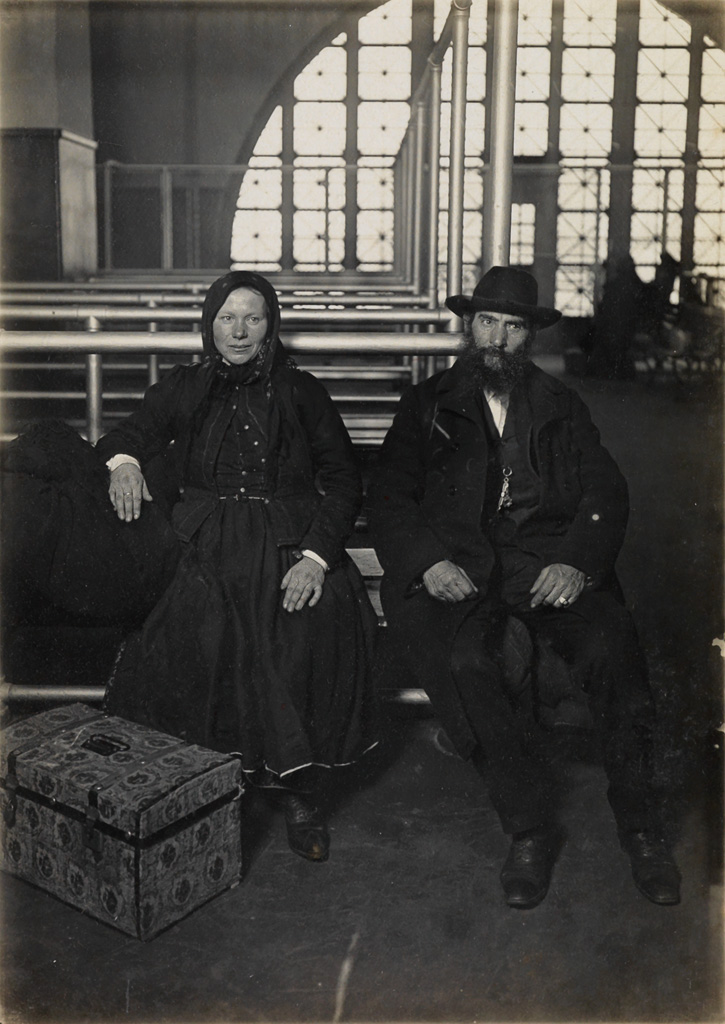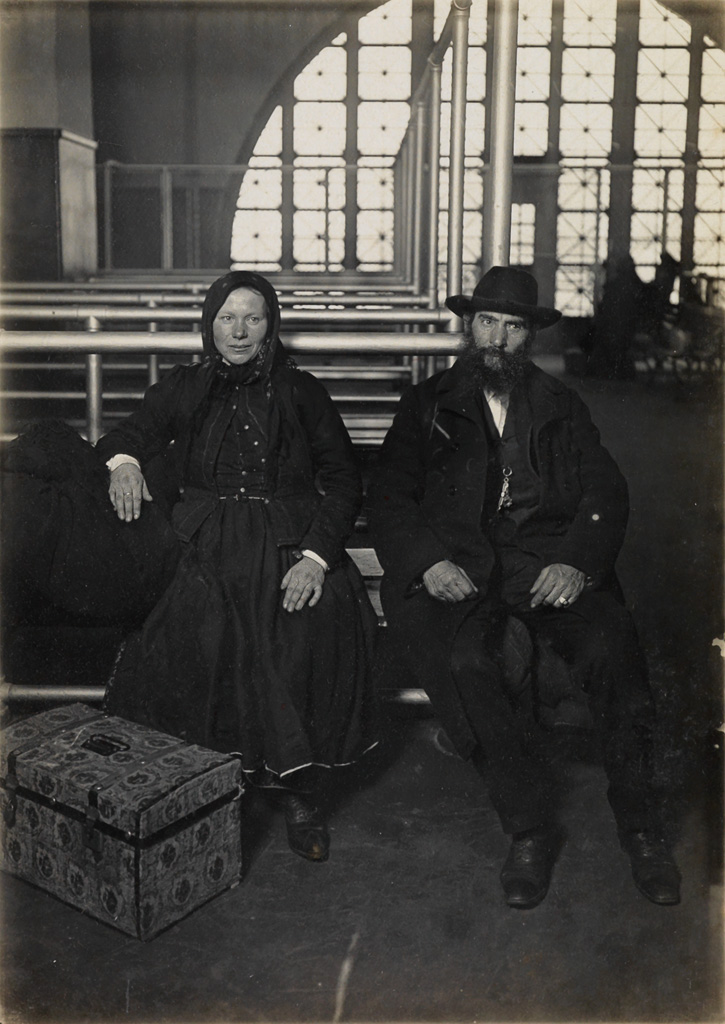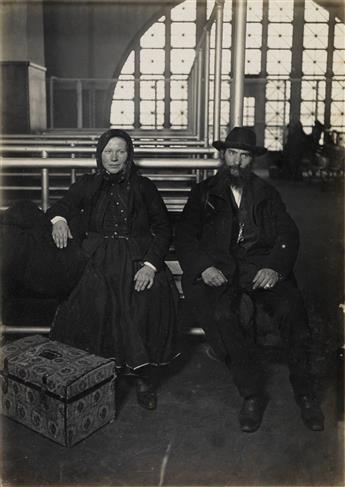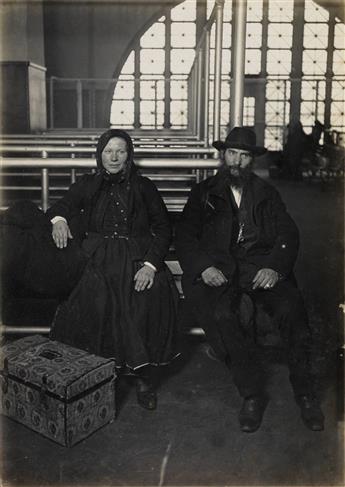Sale 2374 - Lot 11
Unsold
Estimate: $ 10,000 - $ 15,000
HINE, LEWIS W. (1874-1940)
Couple, Ellis Island. Silver print, 6 5/8x4 3/4 inches (16.8x12.1 cm.), with the Hine Photo Company Yonkers, N.Y. hand stamp with the print number and set number, in ink, and again in pencil, on verso. 1905-12
Couple, Ellis Island. Silver print, 6 5/8x4 3/4 inches (16.8x12.1 cm.), with the Hine Photo Company Yonkers, N.Y. hand stamp with the print number and set number, in ink, and again in pencil, on verso. 1905-12
Additional Details
From the Estate of Susan H. Clay, who worked for the King Library Press at the University of Kentucky, and mounted a show of Lewis Hine's photographs at the Skydome Gallery.
"Now, suppose we are elbowing our way thru the mob at Ellis Island trying to stop the surge of bewildered beings oozing through the corridors, up the stairs and all over the place, eager to get it all over and be on their way. Here is a small group that seems to have possibilities so we stop 'em and explain in pantomine that it would be lovely if they would only stick around just a moment . . . We get the focus, on ground glass of course, then hoping they will stay put, get the flash lamp ready." -- Lewis W. Hine
During the course of his 35-year-long career, Lewis Wickes Hine was the first American photographer to develop the social documentary idiom. A Midwesterner by birth, he studied with John Dewey and began his career in New York City during the powerful Progressive era. Hine worked with leading social reformers to address issues relating to immigrants, child laborers, and tenement home-workers; his pictures were among the earliest pictorial documents to depict social groups considered "other." Hine's innovative use of photographs and text, and his insistence on controlling their graphic presentation in social welfare journals, popular magazines, and illustrated books, positions him as one of America's premier photojournalists.
Hine's first body of work depicts immigrants arriving at Ellis Island. In 1904, public sentiment towards immigrant groups was decidedly harsh, and federal immigrant quotas were strictly regulated. At this time, he was also a teacher of nature study and geography at the Ethical Culture School, in New York City, whose student body was largely first-generation European-Jewish immigrants.
Hine began the project at the suggestion of Frank Manny, the school's principal, who also assisted him. Manny ignited the volatile pan of flashpowder while Hine (an expert mime) engaged with individuals, couples and families, whom he captured wth a 5x7 Graflex. According to photo historian Naomi Rosenblum, "Manny saw a need for students to have the same regard for contemporary immigrants as they had for the Pilgrims who landed at Plymouth Rock."
The Ellis Island portraits are among the rarest of Hine's pictures. At a time when appreciation of photography as a fine art form was still in its infancy (Stieglitz founded Camera Work magazine in 1904), these poignant photographs expanded the medium's aesthetic reach and set a standard for what later became known as "humanistic photography."
"Now, suppose we are elbowing our way thru the mob at Ellis Island trying to stop the surge of bewildered beings oozing through the corridors, up the stairs and all over the place, eager to get it all over and be on their way. Here is a small group that seems to have possibilities so we stop 'em and explain in pantomine that it would be lovely if they would only stick around just a moment . . . We get the focus, on ground glass of course, then hoping they will stay put, get the flash lamp ready." -- Lewis W. Hine
During the course of his 35-year-long career, Lewis Wickes Hine was the first American photographer to develop the social documentary idiom. A Midwesterner by birth, he studied with John Dewey and began his career in New York City during the powerful Progressive era. Hine worked with leading social reformers to address issues relating to immigrants, child laborers, and tenement home-workers; his pictures were among the earliest pictorial documents to depict social groups considered "other." Hine's innovative use of photographs and text, and his insistence on controlling their graphic presentation in social welfare journals, popular magazines, and illustrated books, positions him as one of America's premier photojournalists.
Hine's first body of work depicts immigrants arriving at Ellis Island. In 1904, public sentiment towards immigrant groups was decidedly harsh, and federal immigrant quotas were strictly regulated. At this time, he was also a teacher of nature study and geography at the Ethical Culture School, in New York City, whose student body was largely first-generation European-Jewish immigrants.
Hine began the project at the suggestion of Frank Manny, the school's principal, who also assisted him. Manny ignited the volatile pan of flashpowder while Hine (an expert mime) engaged with individuals, couples and families, whom he captured wth a 5x7 Graflex. According to photo historian Naomi Rosenblum, "Manny saw a need for students to have the same regard for contemporary immigrants as they had for the Pilgrims who landed at Plymouth Rock."
The Ellis Island portraits are among the rarest of Hine's pictures. At a time when appreciation of photography as a fine art form was still in its infancy (Stieglitz founded Camera Work magazine in 1904), these poignant photographs expanded the medium's aesthetic reach and set a standard for what later became known as "humanistic photography."
Exhibition Hours
Exhibition Hours
Aliquam vulputate ornare congue. Vestibulum maximus, libero in placerat faucibus, risus nisl molestie massa, ut maximus metus lectus vel lorem.






